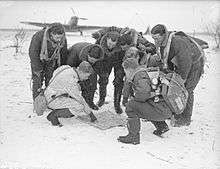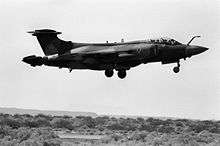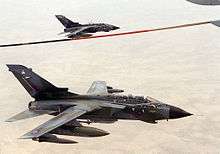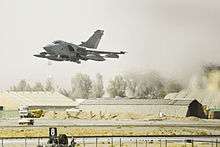No. 12 Squadron RAF
| No. 12 Squadron RAF | |
|---|---|
 | |
| Active | 14 February 1915 – 31 March 2014 9 January 2015 - present |
| Role | Air Interdiction, Ground Attack, Close Air Support, Reconnaissance, Suppression of enemy Air Defenses |
| Garrison/HQ | RAF Marham |
| Motto(s) | "Leads the Field" |
| Equipment | Tornado GR4 |
| Battle honours | Western Front 1915–1918, Loos, Somme 1916, Arras, Cambrai 1917, Somme 1918, Hindenburg Line, France and Low Countries 1939–1940, Meuse Bridges, Fortress Europe 1940–1944, German Ports 1941–1945, Biscay Ports 1940–1945, Berlin 1941–1945, Ruhr 1941–1945, France and Germany 1944–1945, Rhine*, Gulf 1991*, Iraq 2003 |
| Commanders | |
| Current commander | Wing Commander Nikki Thomas |
| Insignia | |
| Squadron Badge | A fox's mask |
| Squadron roundel |
 |
No. 12 Squadron of the Royal Air Force operates the Tornado GR4 from RAF Marham, having been re-formed on 9 January 2015.
History
No. 12 Squadron Royal Flying Corps was formed in February 1915 from a flight of No. 1 Squadron RFC at Netheravon. The squadron moved to France in September 1915 and operated a variety of aircraft on operations over the Western Front. In March 1918 the squadron was re-equipped with the Bristol F2b Fighter just before becoming part of the newly formed Royal Air Force. The squadron, by then based at Bickendorf in Germany, was disbanded in 1922.
The squadron re-formed at RAF Northolt on 1 April 1923 to operate the de Havilland DH.9A. In 1924 it moved to RAF Andover and converted to the Fairey Fawn, a single-engined biplane bomber. The Fawns were replaced in 1926 with the Fairey Fox, which influenced the adoption of the fox's head as part of the squadron badge; the squadron was the only RAF user of the Fairey Fox and its performance was superior to other types, i.e. it led the field. In 1931 the squadron re-equipped with the Sydney Camm designed Hawker Hart. In October 1935 the squadron moved to the Middle East, but returned to Andover in August 1936. The Harts were replaced by the Hawker Hind in 1936 and in 1938 the squadron was equipped with Fairey Battles.

On the first day of the Second World War the squadron moved to France to begin operations. On 12 May 1940, over the Albert Canal, Belgium, one bridge in particular was being used by the invading German army, with protection from fighter aircraft, anti-aircraft and machine-guns. The RAF was ordered to demolish this vital bridge, and five Fairey Battles from the squadron were dispatched. They met an inferno of anti-aircraft fire, but the mission was accomplished, much of the success being due to the coolness and resource of the pilot Flying Officer Garland of the leading aircraft and the navigation of Sergeant Gray. Unfortunately the leading aircraft and three others did not return. Flying Officer Garland and Sergeant Gray were both posthumously awarded the Victoria Cross.
The squadron returned to England in June. It was stationed initially at RAF Finningley, arriving at RAF Binbrook in July 1940, when it was refurnished with Battles. Amongst other missions, it carried out anti-invasion strikes against shipping in Boulogne Harbour, most notably on 17 and 19 August. The Squadron was one of the last No.1 Group units to conduct operations with Fairey Battles. These took place on 15/16 October 1940, when No. 301 (Polish) Squadron bombed Boulogne and Nos. 12 and 142 Squadrons bombed Calais.
By November 1940, the Squadron had been completely re-equipped with the Vickers Wellington, remaining for the time being at RAF Binbrook. The squadron moved again in 1942, to RAF Wickenby, and soon after converted to operate the Avro Lancaster. In 1946 the squadron re-equipped with the Avro Lincoln until, in 1952, it joined the jet-age and re-equipped with the Canberra jet bomber. After 44 years continuous service the squadron was again disbanded in July 1961.

In 1962 the squadron was re-formed to operate eight Avro Vulcan V bombers, initially from RAF Coningsby then RAF Cottesmore, equipped with Yellow Sun one megaton free-fall strategic nuclear bombs for medium to high altitude release. The advent of effective Soviet SAMs made high-flying bombers vulnerable, and in late 1966 the squadron took delivery of eight WE.177B strategic nuclear laydown bombs for low-level penetration missions, and, still based at Cottesmore, were assigned to SACEUR as part of the UK strategic nuclear forces deployed with that 450 kt weapon, that was intended as a temporary stop-gap until the UK Polaris force began to take over the strategic nuclear delivery role.[1] The squadron stood down from this role at the end of 1967.[2][3]

No.12 squadron re-formed at RAF Honington in October 1969 with 12 Buccaneer aircraft assigned to SACLANT in the anti-shipping role, equipped with 12 WE.177 nuclear bombs and free-falling conventional HE bombs,[4] and from 1974 with Martel missiles for non-nuclear strike. The squadron moved to RAF Lossiemouth in 1980, still in the same anti-shipping role.[5] In 1993 it was disbanded once more.
Panavia Tornado: 1993-present
In September 1993, No. 27 Squadron RAF, then at RAF Marham, disbanded and immediately re-formed as No.12 Squadron operating twelve Tornado GR1 aircraft equipped with eighteen WE.177 nuclear weapons[6] and relocated to RAF Lossiemouth.
During December 1998, the Squadron took part in Operation Desert Fox, the four-day air campaign against Iraq. Deployments to the Gulf continued, flying the upgraded Tornado GR4 from 2001, and included major contributions in 2003 as part of Operation Telic as well as supporting the first free elections in Iraq for 50 years in January 2005. In 2006 and again in 2008 the Squadron provided armed overwatch for UK and US ground operations in Iraq. Shortly afterwards, as British troops withdrew from the country, the Tornado fleet based in the region also returned to the UK, marking the end of a long era of the aircraft in theatre.[7]

In June 2009 the squadron deployed ten jets to Cyprus, eight of which continued to Kandahar in Afghanistan. This marked the start of Tornado GR4 operations in Afghanistan, with the type replacing the Harrier GR.9 in theatre. For over four months No. 12 Squadron successfully provided support to the International Security Assistance Force (ISAF), including close air support for, amongst others, British, American, Canadian and Afghan troops in all parts of the country. On 16 October 2009 12 Squadron returned to Lossiemouth after having handed over to a Marham-based GR4 squadron.
Between subsequent Operation Herrick deployments during 2011, 12 (Bomber) Squadron was deployed in support of Operation Ellamy, the UK’s participation in the military intervention in Libya under United Nations Security Council Resolution 1973. This saw ten aircrew deploy to Gioia del Colle to bolster the Tornado component during the peak of operations. The remainder of the Squadron was held at readiness to move to RAF Marham to launch Storm Shadow raids on hardened Libyan targets. These missions required three air-to-air refuelling brackets on the outward journey and one further on return to Gioia Del Colle.
No. 12 Squadron operated from RAF Lossiemouth and operated the Tornado GR4 in a variety of roles, from close air support and strike bombing to training missions. No. 12 Squadron disbanded on 31 March 2014 under the command of Wing Commander Simon Strasdin.[8][9][10]
Current Status
Having redeployed from Afghanistan as part of Operation Herrick, No. 2 Squadron RAF equipped with eight Tornado GR4's was deployed to RAF Akrotiri as part of Operation Shader, a coalition undertaking air strikes against the Islamic extremist group ISIL in Iraq. Under the 2012 Strategic Defence Review, all Tornado aircraft were due to be withdrawn from RAF operations by the end of 2015, and so No. 2 Squadron RAF was to stand down on 31 March 2015 as a Tornado squadron at RAF Marham, and reactivate the following day as a Typhoon squadron at RAF Lossiemouth.[11]
However, in October 2014, Prime Minister David Cameron said that No.2 Squadron's disbanding and reformation would be put on hold to allow the retention of Tornados to support strikes against ISIL. As a consequence of this new plan, the new No.2 Squadron formed at Lossiemouth on 12 January 2015, and 12 Squadron re-formed the same day at RAF Marham, taking over the former Tornado aircraft and assets of No.2.[12][13] The re-formed squadron is commanded by Wing Commander Nikki Thomas, the first female RAF officer to command a fast jet squadron.[14]
In August 2015, Jane's reported that the squadron will stay active for a longer period.[15]
In September 2016, No.12. was deployed to Syria for reconnaissance of ISIS troop movements.
Aircraft operated

- 1915 Avro 504
- 1915–1917 Royal Aircraft Factory BE 2c
- 1915 Martinsyde S.1
- 1915 Royal Aircraft Factory BE 2b
- 1915 Voisin LA
- 1915–1916 Royal Aircraft Factory RE 7
- 1915–1916 Royal Aircraft Factory RE 5
- 1915 Morane H
- 1915–1916 Bristol Scout
- 1915–1916 Morane LA
- 1916 Royal Aircraft Factory FE 2b
- 1916 Morane BB
- 1916–1917 Royal Aircraft Factory BE 2d
- 1916–1917 Royal Aircraft Factory BE 2e
- 1917–1919 Royal Aircraft Factory RE 8
- 1918–1922 Bristol F2B Fighter
- 1923–1924 Airco DH.9A
- 1924–1926 Fairey Fawn
- 1926–1931 Fairey Fox
- 1931–1936 Hawker Hart
- 1936–1938 Hawker Hind
- 1938–1940 Fairey Battle
- 1940–1942 Vickers Wellington II
- 1942 Vickers Wellington III
- 1942–1946 Avro Lancaster I & III
- 1946–1952 Avro Lincoln B2
- 1952–1955 English Electric Canberra B2
- 1955–1961 English Electric Canberra B6
- 1957–1959 English Electric Canberra B2
- 1962–1967 Avro Vulcan B2
- 1969–1993 Hawker Siddeley Buccaneer S2B
- 1993–2001 Panavia Tornado GR1
- 2001– Panavia Tornado GR4
References
Notes
- ↑ Weapon overview @ www.nuclear-weapons.info/vw.htm#Weapon X
- ↑ Weapon overview @ www.nuclear-weapons.info/vw.htm#WE.177 Carriage
- ↑ Weapon history detail @ www.nuclear-weapons.info/images/1966-67
- ↑ Weapon history detail 1970
- ↑ Weapon history detail 1981
- ↑ Weapon history detail @ www.nuclear-weapons.info/images/1994
- ↑ http://www.raf.mod.uk/organisation/12squadron.cfm
- ↑ http://igale.wordpress.com/2013/08/14/raf-lossiemouth-typhoon-main-operating-base-2/
- ↑ Disbanded squadron will keep history alive
- ↑ http://www.raf.mod.uk/news/archive/final-salute-for-historic-raf-squadrons-28032014
- ↑ "New Typhoon squadron announced". GOV.UK. UK Government. 13 December 2013. Retrieved 10 February 2014.
- ↑ Ripley, Tim (4 December 2014). "Final UK Typhoon squadron to stand up". IHS Jane's 360. Jane's. Retrieved 6 January 2015.
- ↑ "II(AC) Sqn re-role and reformation of 12(B) Sqn". Royal Air Force. 12 January 2015. Retrieved 23 January 2015.
- ↑ http://www.telegraph.co.uk/news/uknews/defence/11335480/First-woman-to-command-an-RAF-fast-jet-squadron-named-as-Wing-Commander-Nikki-Thomas.html
- ↑ http://www.janes.com/article/53408/uk-extends-reformed-tornado-unit-for-operations-over-iraq
Bibliography
- G G Jefford, RAF Squadrons, second edition 2001, Airlife Publishing, UK, ISBN 1-84037-141-2.
External links
| Wikimedia Commons has media related to No. 12 Squadron RAF. |
Video clips
- A charity event by RAF No. 12 Sqn ground crew marshalling during a NATO meet on YouTube, accessed 20 October 2009.